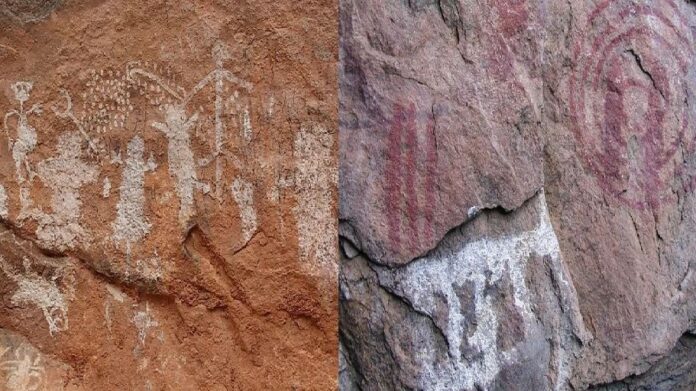The predecessors of the Chewa and Nyanja people of central Africa were among the most productive of Africa’s rancher rock artists.
Various hundred Chewa rock art similarities have spread across focal Malawi, eastern Zambia, and bordering spaces of Mozambique.
Almost more than two-thirds of the realized locales fall inside the Dedza-Chongoni slopes of Malawi, and it appears to be that this was a central region for Chewa art.
The primary colors used in Chewa art
As is typical of rock art customs made by African ranchers, the actual color utilized is white, which is applied thickly by wiping.
In uncommon occurrences where the art is safeguarded exceptionally all-around, the artists might execute dark finger-painted adornment over the essential white plan.
The white shade is powdered dirt that you can uncover from underneath most riverbeds around here.
A similar color is utilized in customary house adornment today, and the dark color is powdered charcoal.
The two colors blend, neither utilizing just water nor firmly attached to the stone surfaces.
Rock inscriptions (otherwise called petroglyphs) are obscure in these practices.
The Nyau rock art
The art of nyau is a practice that has a place with Chewa men. Nyau rock art is similarly uncommon and crisp looking when contrasted and chinamwali rock art.
Two or three dozen locales are known. It portrays a scope of veiled men and, in particular, more enormous creature basketwork figures.
These are promptly unmistakable as the complex concealed characters that act in the functions of the nyau shut affiliation (see passage for nyau shut affiliation).
While the topic of the art is known, the art did not just begin today, and the creation of the art is not a result of recollection generally.
It has been contended that the nyau art custom had a place with the particular authentic setting of the nineteenth and mid-20th hundreds of years when you had to turn into an underground development due to its concealment by Ngoni trespassers, missions, and the colonial government.
As per this clarification, the art-filled in as a memory aid, assisting with showing youthful starts of the development and means of massive nyau structures that artists can make in the present time.
The art left to use when the concealment of nyau finishes and starts could be learned by making and utilizing simple designs.
The artists hence eliminated the requirement for stone art.
The idea behind Chewa rock art
The art of chinamwali is undeniably more varied. In light of the many layers of superpositions – above twelve at specific locales – it is a custom with a far more important relic than nyau art.
It appears to be probable that this custom of art has been relaxed of the soonest progenitors of the Chewa around here, more than 1,000 years prior.
It, accordingly, is customary Chewa rock art, connected to Chewa ladies and the young lady’s transitioning function: chinamwali.
The painted imagery revolves around ideas identifying with water and fruitfulness.
It conveys numerous enlightening messages that instruct and remind people going to chinamwali how to act and react.
Comparative plans to stone art are displayed in dirt and utilized in chinamwali, playing various functions in many central African areas.
These plans each have a name, a dance, and an informative tune, and the picture assists the little youngsters with recollecting the numerous and complex educating of the function.
Bottom Line
The topic of these plans and their structure recommend close equals with Chewa rock art.
It appears logical that there’s a connection between the pictures in the stone art and melody and movement.
Today chinamwali rock art is not generally made, although people are yet to utilize a portion of the sanctuaries with this art for chinamwali functions.
There are signs that the mysterious implications of large numbers of the plans are not apparent yet. However, there has been no distributed affirmation of this to date.


